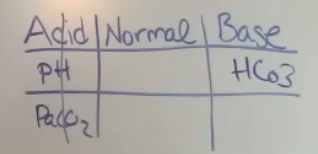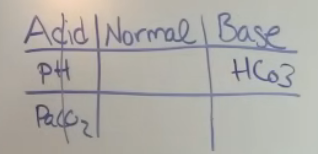ABG made easy
1/14
There's no tags or description
Looks like no tags are added yet.
Name | Mastery | Learn | Test | Matching | Spaced |
|---|
No study sessions yet.
15 Terms
normal pH of blood
7.35-7.45
normal HCO3 range
22-26
blood with a pH of 7.7 is considered
base
HCO3 represents
metabolic
HCO3 over 26 is
basic
HCO3 under 22 is
acidic
blood with a pH of 7.0 is considered
acidic
PaCO2 represents
respitory
Normal PaCO2 range
35-45
PaCO2 less than 35 is
basic (opposite from HCO3 and blood)
PaCO2 greater than 45 is
Acidic (opposite from HCO3 and blood)
How do you set up an ABG tictactoe board? draw it out!

Use the tictactoe board to solve this problem!
Your client has a pH of 7.23, PACO2 of 50, and a HCO3 of 30
Step 1:fill out the tic tac toe board

Use the tictactoe board to solve this problem!
Step 2: What kind of issue is the client experiencing? How do you know?
Respirtory acidosis
We know this because we got a tic-tac-toe in the acid column and PACO2 was in it, meaning it is respirtory issue

Use the tictactoe board to solve this problem!
Step 3: Is the client’s body compensating? How can you tell?
Partially compensating
We know this because HCO3 is in the base column, meaning it is on the opposite end of the spectrum trying to bring body back to homeostasis
(if it was in the normal column the body would not be trying to compensate)
